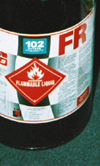Respondez s'il vous plait
 We've all received them at some time in our lives. That invitation to so-and-so's wedding that spreads mild panic in the household. A new outfit for the wife, a few modifications to the waistband of that old suit of mine, and the prospect of being away from the workshop for a whole weekend. At the bottom of the card the letters 'RSVP' demand an almost immediate reply and so inspiration for damage limitation has to come - and come quickly.
We've all received them at some time in our lives. That invitation to so-and-so's wedding that spreads mild panic in the household. A new outfit for the wife, a few modifications to the waistband of that old suit of mine, and the prospect of being away from the workshop for a whole weekend. At the bottom of the card the letters 'RSVP' demand an almost immediate reply and so inspiration for damage limitation has to come - and come quickly.
But in the world of fuels, simply removing the 'if' or 'si' in French, produces a totally different connotation. RVP, you must understand, stands for Reid Vapour Pressure. A measure of the pressure of the fuel vapour at 100 F (37.8 C), this is just one of the parameters used to measure the volatility of a fuel. The RVP is therefore the vapour pressure of the fuel obtained when the air:liquid ratio is 4:1 at the given temperature, and measuring it cannot be simpler.
The procedure involves filling a metal chamber with a chilled sample and connecting it to another, this time an air chamber of precisely four times the volume. The equipment is totally immersed in a water bath at 100 F and the whole lot agitated until a constant pressure reading is obtained. Unlike some of the other measurements of volatility - such as distillation curve or vapour-liquid ratio - the RVP is simple, quick and therefore cheap. But after going through all this rigmarole what does it actually tell us?
In the world of road transport engines the RVP is intended to give an indication of cold-weather driveability. Too low a vapour pressure and the engine may be difficult to start, even with pre-heating as in a race unit. To high a vapour pressure and the engine could be difficult to start when hot and suffer from a phenomena known as 'vapour lock'.
A common issue with competition engines, vapour lock is more likely to affect carburettor systems under hot restart conditions. Here vapour formation in the fuel pump normally created as a result of 'heat soak' can interfere with the pumping, making the fuel-air mixture too lean and difficult to re-ignite. In fuel-injected engines the issue is essentially the same but the higher fuel rail pressures involved tend to delay the onset of the problem to the point where vapour lock is only rarely experienced.
In Europe, service station forecourt fuels are separated into eight volatility classes, and the volatility available from summer to winter across the continent will depend on the prevailing weather conditions expected in that part of the globe at that time of the year. Buying a pump fuel in one place and then moving on to race somewhere warmer or colder can therefore introduce fuel system issues.
The RVP is much more controlled for race fuels, and will remain the same summer or winter - but only provided the containers are tightly sealed! However, if travelling to warmer climes it might be as well to inform your fuel supplier so that he can best advise not only on your choice of fuel but how best to transport it.
The RVP is only one measure of fuel volatility though, and applies to the 'light' ends of the fuel 'boiling' off at the lower temperatures only. In terms of overall fuel volatility there is a bit more to it than that.
Fig. 1 - Fuel barrel
Written by John Coxon